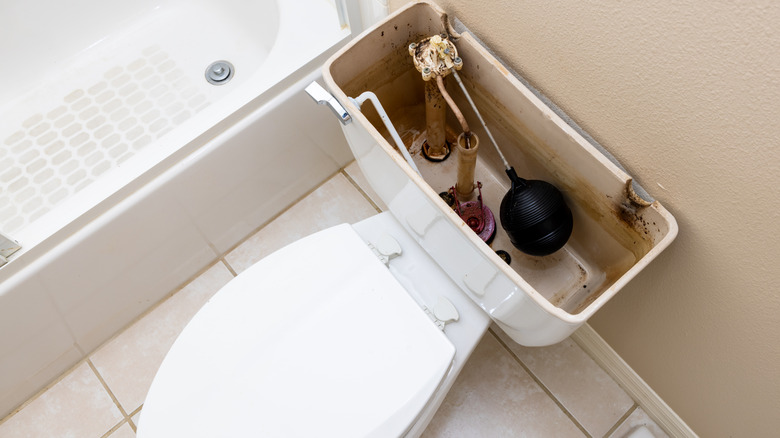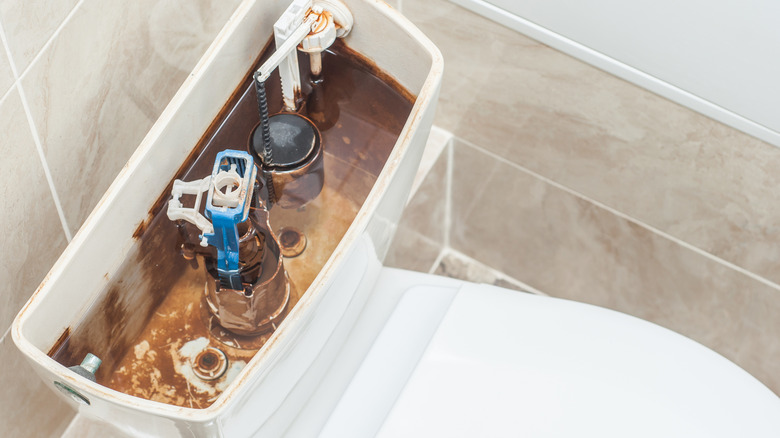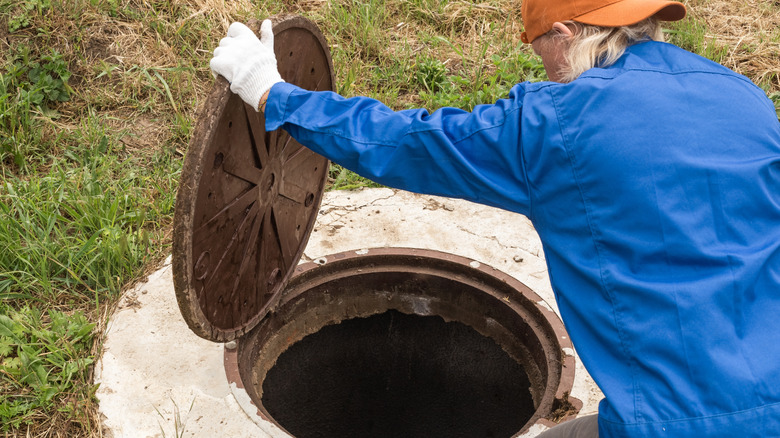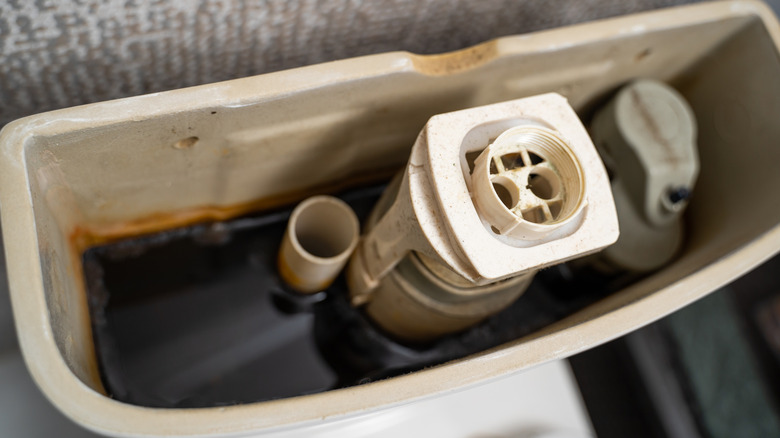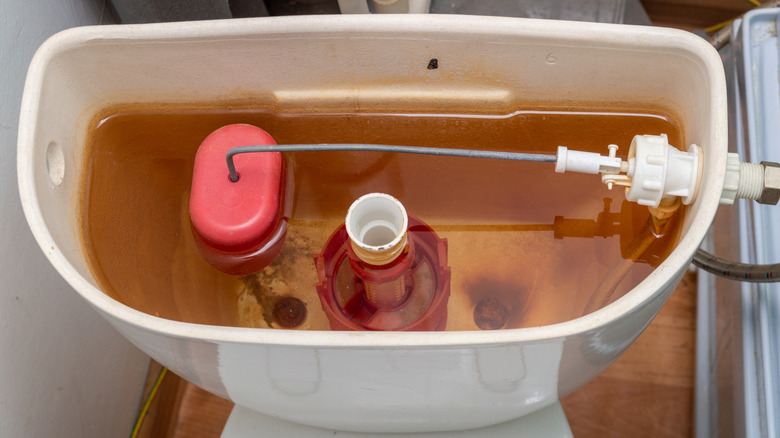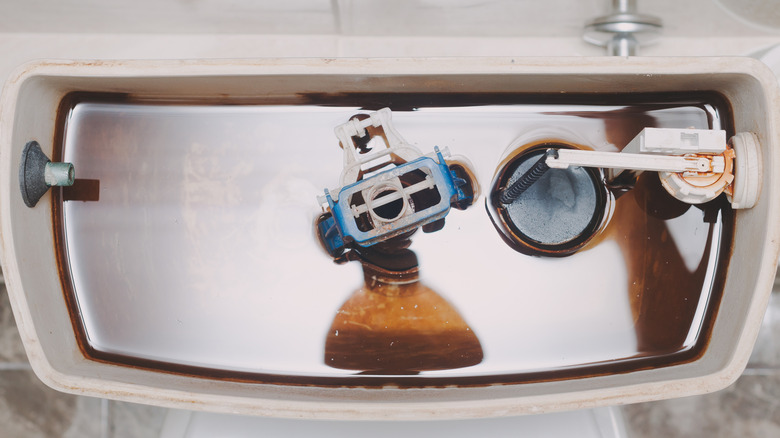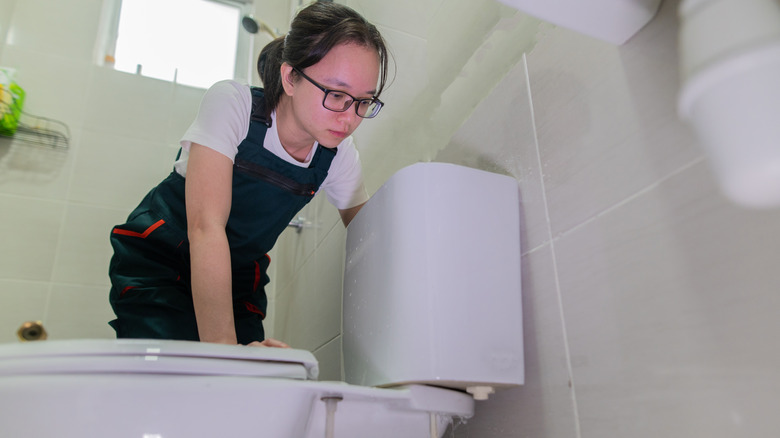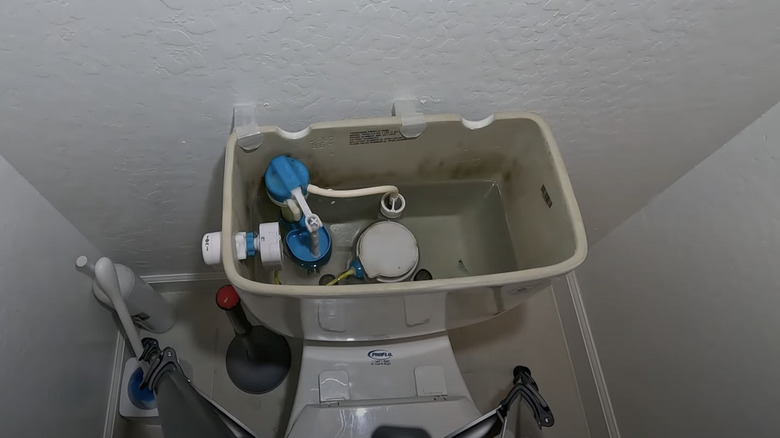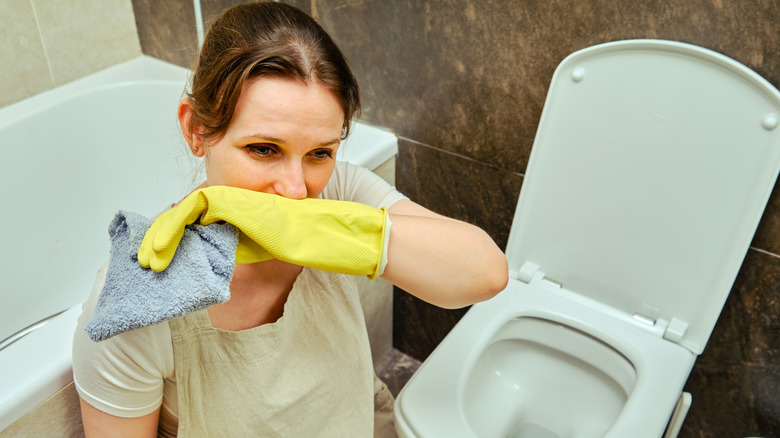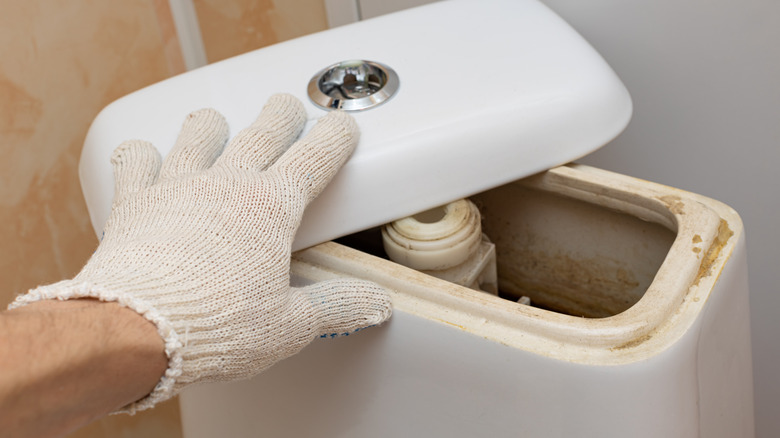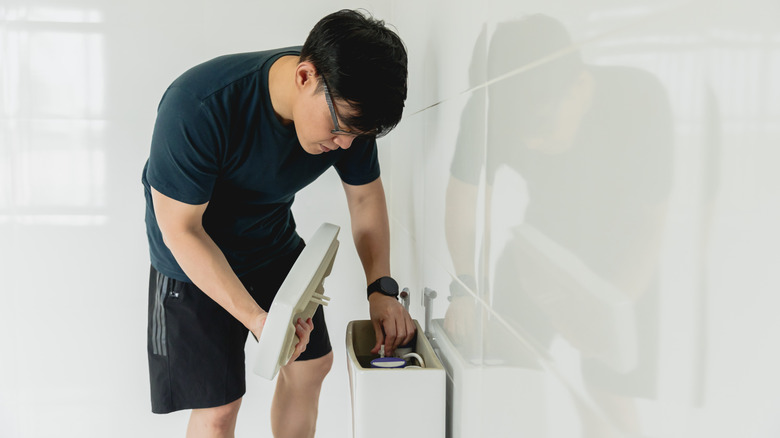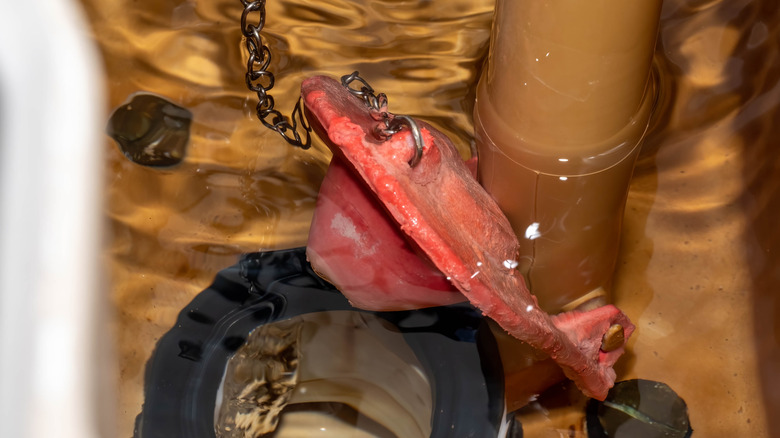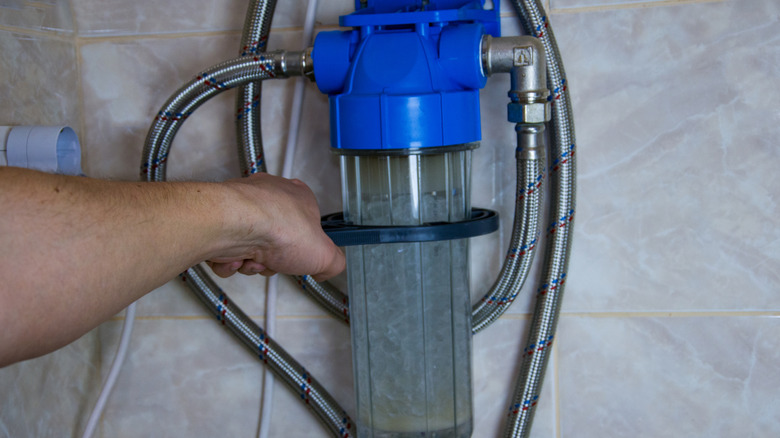12 Toilet Tank Problems That Can Alert You To A Bigger Water Problem
When your toilet suddenly stops flushing or filling correctly, taking a look inside the tank will usually help you diagnose the problem. Sometimes, what's going on inside your toilet tank can let you know that there's something bigger going on with your water supply or even your pipes. Whether you're using a municipal water system or rely on a well, various minerals and bacteria will sometimes be present in the water filling up your toilets and coming out of your faucets. Noticing that the color of the water in your toilet tank has changed or finding strange stains on the sides of the tank are indications that there's more going on than you may realize.
In some cases, problems with your toilet tank could signal a simple and temporary obstacle, like your city flushing the water system. Other times, toilet tank issues are a sign of poor water quality, including mold or bacteria, or persistent problems with minerals from hard water. By regularly inspecting your toilet tank for any staining, deposits, slime, or changes in water color, you'll know if there's a larger issue with your water and be able to fix it promptly.
Rust deposits and stains in your tank could mean there's excess iron in your water
Finding orange colored deposits at the bottom of your toilet tank or dark stains along the sides of the tank could mean there's a lot of iron present. For people with older homes and plumbing systems, your galvanized pipes may be deteriorating over time, leading to sediment and rust in your toilet tank. With the pipes slowly coming apart, it's crucial to replace them. If your pipes aren't the problem, the rust in your toilet tank could indicate issues with your water quality. An excess of iron in your water will not only stain your toilet, but it could begin to damage the mechanisms inside the tank by causing them to rust. Too much iron could eventually lead to the development of iron bacteria as well.
An easy way to remove toilet rust stains is with an acidic cleaner, such as vinegar or lemon juice. For particularly tough stains, you may need to scrub the tank with a scouring pad and try a rust-removing product. While this will solve the immediate issue of stains inside your tank, it won't prevent them from coming back. Installing a filter on your home's water system that catches iron is a great way to prevent these deposits from building up in your toilet tank and to improve your water quality.
Slimy strings growing on the sides of your toilet tank are a sign of bacteria in your well
Taking the lid off your toilet tank and seeing stringy slime growing along the sides is alarming. This slime is typically caused by iron bacteria or sulfur bacteria, which can also make the water look foamy. Iron bacteria is often an issue with well water systems that have an abundance of iron and is a sign that you may have poor water quality. Since cities typically filter out metals from their water, iron bacteria is not usually a problem for those using municipal systems. While they're not dangerous for your health, iron and sulfur bacteria can clog or corrode your plumbing and may give your water a bad odor and flavor.
Sulfur and iron bacteria can be really troublesome to remove once they've gotten into your water system, but you can try to treat your water with ozone or chlorine shock treatments to kill it. These bacteria generally get into wells during construction, upkeep, or if any parts of the system come into contact with soil. You can prevent the bacteria from growing in your water by shocking it with chlorine after opening the well cap. Filtering iron out of your system can also help to avoid issues with iron bacteria.
Black water in your toilet tank might indicate problems with water quality
Discovering that the water in your tank has turned a dark color may feel like your bathroom is in a horror film, but what it means when your toilet water is black is simpler. This frightening color is an indication of bad water quality due to an overabundance of manganese or ferric sulfide, also known as black rust. Over time, this mineral can build up in your plumbing, leaving deposits and issues with the water flow, and very high amounts of manganese could prove harmful to your health.
Unfortunately, getting manganese out of your water isn't always easy. Though iron filters can help separate out some of this mineral, you may need treatments from a professional to eliminate manganese from your water. Water softeners will not remove manganese and actually be harmed by the mineral. To protect your home's plumbing and other appliances, it's important to address black water in your toilet tank promptly.
Yellow or rusty colored water in your tank is caused by excess calcium and iron
When the water in your toilet tank suddenly appears yellow or a rusty color, there's a chance that your city recently flushed the pipes and sediment is ending up in your system. If this is the case, the issue should clear up quickly and won't signal a larger problem with your water. Otherwise, rusty or yellow colored water in your tank might suggest that the city water is having issues with treatment or that your well system has too much iron or calcium. These minerals will build up over time, and as there are more calcium deposits and rust in your tank, the water will slowly become more and more yellow.
Hard water with a lot of calcium may also damage your plumbing with time, leaving limescale deposits and also causing corrosion to your pipes and system. If you think rust is the culprit of your colored toilet water, an iron filter will be helpful for removing the sediment. For calcium, a water softener can help to get these minerals out of your water and protect your plumbing and appliances.
A high water level in your toilet tank could ramp up your utility bill
Though it doesn't indicate that there's anything wrong with the quality of your water, a toilet tank with a high water level is a sign that you might be spending more than necessary on your utility bill. When there's too much water in the tank, it will spill into the overflow tube. With the tank continuously filling and emptying through the overflow, your toilet will be running non-stop, wasting water and money. While the fix may be as simple as lowering your floater to prevent the water from filling higher than that point, this issue could also indicate a leak somewhere in your toilet.
Toilet tanks that have a very high water level and run night and day can make a big impact on your water usage and expense, but they may be letting you know that something is wrong with the fill valve. A leaking fill valve can add extra water into the tank, raising the level and causing the toilet to keep running. Check the valve inside your tank for any damage or cracks and replace it if necessary.
Your toilet tank might have a leak if the water level is low or empty
While a high water level can be a problem for your toilet tank, a very low water level or an empty tank can also signal some deeper plumbing issues. With little water in the tank, your toilet may not be able to flush properly or will have a weaker flush. This can sometimes be fixed by simply adjusting the floater to allow more water into the tank, but if that's not the culprit, you could have bigger problems on your hands. A leaking fill valve or a crack in the tank could be causing the water to leak somewhere outside of the toilet, potentially causing water damage in your home. Unfortunately, a low water level in your toilet tank may also be a sign of a clog within the sewer line vent that'll require professional maintenance.
If adjusting the floater doesn't raise the water level, check your tank and fill valve for any damage, cracks, or leaks. Once you locate the leak, shut off the water to your toilet. You might need to replace the fill valve or use a sealer to fill the cracks in the porcelain tank to stop water from spilling into your bathroom and home and causing harm. Your entire toilet may need to be replaced if there's extensive damage to the tank that can't be sealed.
Mold inside your toilet tank could signal that there's bacteria in your water
Despite frequent and thorough bathroom cleaning, you may not know if mold is hiding in your toilet. Toilet tanks are a common place to find mold, as the dark, wet environment is helpful for its growth, especially if the toilet is only flushed occasionally. While improper bathroom ventilation will sometimes cause mold in your toilet tank, it could be a sign of a more sinister issue. If mold is continually reappearing in your tank despite efforts to clean and remove it, your water quality could be bad. When bacteria gets into your water system, this can encourage mold spores to grow.
Besides bacteria contaminating your water and promoting mold growth, hard water will also contribute to this fungal problem. When deposits form from the minerals, it gives more areas for the mold spores to stick to and grow. Using a water softener to lessen mineral deposits could help prevent mold from continuing to appear in your toilet tank; however, if you think that water quality issues are the cause of the mold, you'll want to have your water tested and treat your system accordingly. Checking other areas of your home for mold spores will also help you know if this problem is extending throughout your house.
If your toilet tank stinks like eggs you might need to treat your well
Opening your toilet tank only to get hit with the smell of rotting eggs is annoying and worrisome. As it turns out, the same iron and sulfur bacteria that can form slime inside the tank is often also responsible for this smelly odor. Noticing an eggy scent coming from the water in your toilet tank tells you that there's likely some bacteria in your water system producing hydrogen sulfide gas, though it's not a health risk.
As more of this bacteria grows, it could do more harm than making your water smell and taste bad. The build up of slime from iron and sulfur bacteria can end up damaging your plumbing system or causing clogs. This is why it's crucial to address the issue quickly and save yourself from more costly problems. Additionally, you'll want to ensure that the bacteria in your well water is not from run-off getting into the system. Sulfur and iron bacteria can be treated and prevented by chlorine shocking your well, banishing the rotten egg scent from your home.
Staining and deposits in your toilet tank could indicate your water is too hard
If you have lighter colored stains and buildup inside your toilet tank, it's likely from the minerals in hard water. Hard water stains often look white, though they're sometimes brown, and they have a texture like chalk due to the calcium and other minerals in the water. These limescale deposits and stains are a pain to try to scrub away, and eventually the hard water could start to damage the parts inside your toilet tank. A few hard water stains let you know that you might want to consider installing a water softener to help get rid of some of the minerals.
Though a couple of tough stains might seem harmless, hard water deposits will eventually form on the mechanisms that fill and flush your toilet, as well as other water fixtures in your home. While you can use acidic cleaners like vinegar to help scrub away hard water stains, investing in a water softening system will prevent buildup and stains from hard water and keep your toilet tank in tip-top shape.
Rust on the toilet chain means hard water is already doing damage
If you've noticed deposits or rust beginning to form on the chain inside your toilet tank, hard water might be the cause of your toilet's problems. As the hard water continues leaving residue from minerals inside the tank, it'll move from staining the porcelain to harming the inner workings of your toilet. A rusty toilet chain probably won't be a big deal at first, but eventually the chain can corrode. Faulty toilet chains may make it hard to flush the toilet, and further corrosion will break the chain, forcing you to reach into the tank to flush. If the rusty chain can't hold the flapper perfectly in place, your toilet could end up running all the time.
When you see hard water beginning to damage your toilet chain, be aware that the hard water will likely start affecting the other mechanisms in your toilet or other appliances in your home. Hot water heaters, showers, dishwashers, and other water features can all be negatively affected by hard water, and the deposits can even clog your pipes. Replacing your toilet chain will solve a temporary problem, but investing in a water softener can save your toilet and home from further troubles with hard water.
A flapper that isn't sealing correctly signals an abundance of minerals in your water
Another sign that your water has an overabundance of minerals is finding an issue with your toilet's flapper. Even if the flapper itself doesn't look worn out, it can fail to seal to the toilet tank properly, keeping your toilet running. As the hard water leaves minerals on the flapper itself and along the opening of the flush valve, the deposits block the flapper from closing tightly. In some cases, the flapper may be lifted so slightly that the water simply drips from the tank into the bowl. This is known as a silent leak and though it may be a little harder to notice, this wasted water can impact your utility costs.
If you're unsure if your flapper has a slow leak, try adding a few drops of food dye to the tank and looking to see if the water in the bowl becomes colored. The minerals from hard water can also damage the rubber flapper itself, causing it to harden and letting you know you need to replace your toilet flapper. Removing the hard water deposits from the opening in the toilet tank and the base of your flapper will help it to seal properly again, if the rubber is still in good condition. Resolving your home's problems with hard water will help to prevent deposits from hindering your flapper.
If your refill tube keeps clogging you might need to soften your water
Like the other mechanisms inside your toilet, the valve that refills your tank with water after flushing can struggle with hard water formations. As the deposits grow larger with time, they'll start to block the flow of water into your toilet, making it weaker or clogging it completely. Without enough water in the tank, your toilet won't be able to fill or flush properly. If you find that the refill tube continually clogs, you'll know your area has consistently hard water and you may want to install a water softener to prevent worse clogs in other parts of your plumbing.
To immediately fix a clogged fill valve, you'll need to remove the mineral buildup by cleaning it with vinegar or another acidic cleaner. This could be somewhat troublesome, as you'll have to turn off your water and unscrew the tube from your toilet tank. To keep yourself from constantly having to scrub hard water stains and remove built-up minerals from your toilet tank, install a water softener in your home to remove magnesium, calcium, iron, and other minerals from your water.
